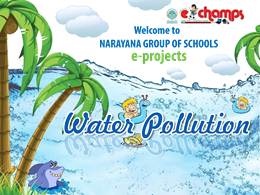Learn more how to embed presentation in WordPress
Copy and paste the code below into your blog post or website
Copy URL
Embed into WordPress (learn more)
Comments
comments powered by DisqusPresentation Slides & Transcript
Presentation Slides & Transcript
Earth our mother planet….
A home for all living beings with abundant
natural resources .
1/4th parts of earth’s surface is covered with land
3/4th parts covered with water
It is from these waters that life first emerged.
We don't know if intelligent life exists elsewhere on
other planets.
What is making our life possible?
Our life is existing because of one of the important resources
on the earth… WATER!
Water a life giving liquid.
But these days this liquid is hampered….
What is the reason?
It is because water is being polluted today.
Let’s see how……..
Water pollution is the contamination of water bodies
(e.g. lakes, rivers, oceans, aquifers and groundwater),very often by
human activities.
Occurs when pollutants are discharged directly or indirectly into water
bodies without adequate treatment to remove harmful compounds.
How is water getting polluted ?
Water comes from many sources. This means they can be polluted in many scenarios. Let's see a few types of water pollution:
Let’s see the causes…
Nutrient Pollution
Some wastewater, fertilizers and sewage contain high levels of nutrients. If they end up in water bodies, they encourage algae and weed growth in the water. This will make the water undrinkable.
Surface water pollution
Surface water includes natural water found on the earth's surface, like rivers, lakes, lagoons and oceans. Any kind of activity that pollutes these surface waters can be called surface water pollution.
Microbiological
Sometimes there is natural pollution caused by microorganisms like viruses,
bacteria and protozoa. This can cause fishes and other water life to die. They can also cause serious illness to humans who drink from such waters. This is called microbiological pollution.
Chemical Water Pollution
Many industries and farmers work with chemicals that end up in water. These include chemicals that are used to control weeds, insects and pests. Metals and solvents from industries can pollute water bodies.
Oil Spillage
Oil spills usually have only a localized affect on wildlife but can spread for miles. The oil can cause the death of many fish and stick to the feathers of seabirds causing them to lose the ability to fly.
Ground water pollution
When humans apply pesticides and chemicals to soils; they are washed deep into the ground by rain water. This gets to underground water and pollute.
Let’s see the effects of water pollution…
Sewage and waste water
Domestic households, industrial and agricultural practices produce wastewater that cause pollution of many lakes and rivers.
Septic Tanks
Septic tanks can pollute groundwater supplies and surface water in rivers, streams and lakes. Such pollution can make supplies unusable for drinking and cause damage to the environment..
Ocean and marine dumping
Paper waste, food waste, plastic, rubber, metallic and aluminum waste
are dumped into the sea water which later leads to cause ocean pollution.
Industrial wastes
Industry is a huge source of water pollution, it produces
pollutants that are extremely harmful to people and the environment.
Asbestos – this pollutant has cancer-causing property. When inhaled,
it can cause illnesses such as asbestosis and many types of cancer.
Lead and Mercury –Non degradable water pollutants .
The effects of water pollution are varied and depend on what
chemicals are dumped and in what locations.
The main problem caused by water pollution is that it kills life
that depends on these water bodies.
Dead fish, crabs, birds and sea gulls, dolphins, and many other animals often
wind up on beaches, killed by pollutants in their habitat (living environment).
Pollution disrupts the natural food chain as well.
Ecosystems (the interaction of living things in a
place, depending on each other for life) can be
severely changed or destroyed by water
pollution.
Eventually, humans are affected by water pollution.
People can get diseases such as hepatitis by eating
seafood that has been poisoned.
There is always outbreak of cholera and diseases
as a result of poor drinking water treatment from
contaminated waters.
With little efforts all of us can prevent water pollution.
Never throw rubbish anywhere. Always look for the waste bin.
If there is none around, please take it home and put it in your
trash can. This includes places like the beach, riverside and
water bodies.
Use water wisely. Do not keep the tap running when not
in use. Also, you can reduce the amount of water you
use in washing and bathing.
Do not throw chemicals, oils, paints and medicines
down the sink drain, or the toilet.
Buy more environmentally safe cleaning liquids for
the use at home and other public places.
They are less dangerous to the environment.
Take great care not to overuse pesticides and fertilizers. This will prevent runoffs of
the material into nearby water sources.
If you live close to a water body, try to plants lots of trees and flowers around your
home, so that when it rains, chemicals from your home does not easily drain into the
water.
Recent advancements to identify water pollution
Natural Biological Indicators
Biological indicators are aquatic plant and animal life that are susceptible to specific types and levels of pollutants.
Potamogeton pectinatus Accumulates lead
Fontinalis antipyretica Indicator of mercury
Ecihhornia, Pistia, Salvinia Nuisance causing (notorious) weeds
Recent advancements to identify water pollution
Natural Biological Indicators
Biological indicators are aquatic plant and animal life that are susceptible to specific types and levels of pollutants.
Cladophora golmerata and Evidence of organically polluted water
Enteromorpha
Chlorella vulgaris
Euglena acus Clear evidence of pollution
More Presentations

By kavitha.chinnari
Published Jan 9, 2013

By kavitha.chinnari
Published Jan 9, 2013





